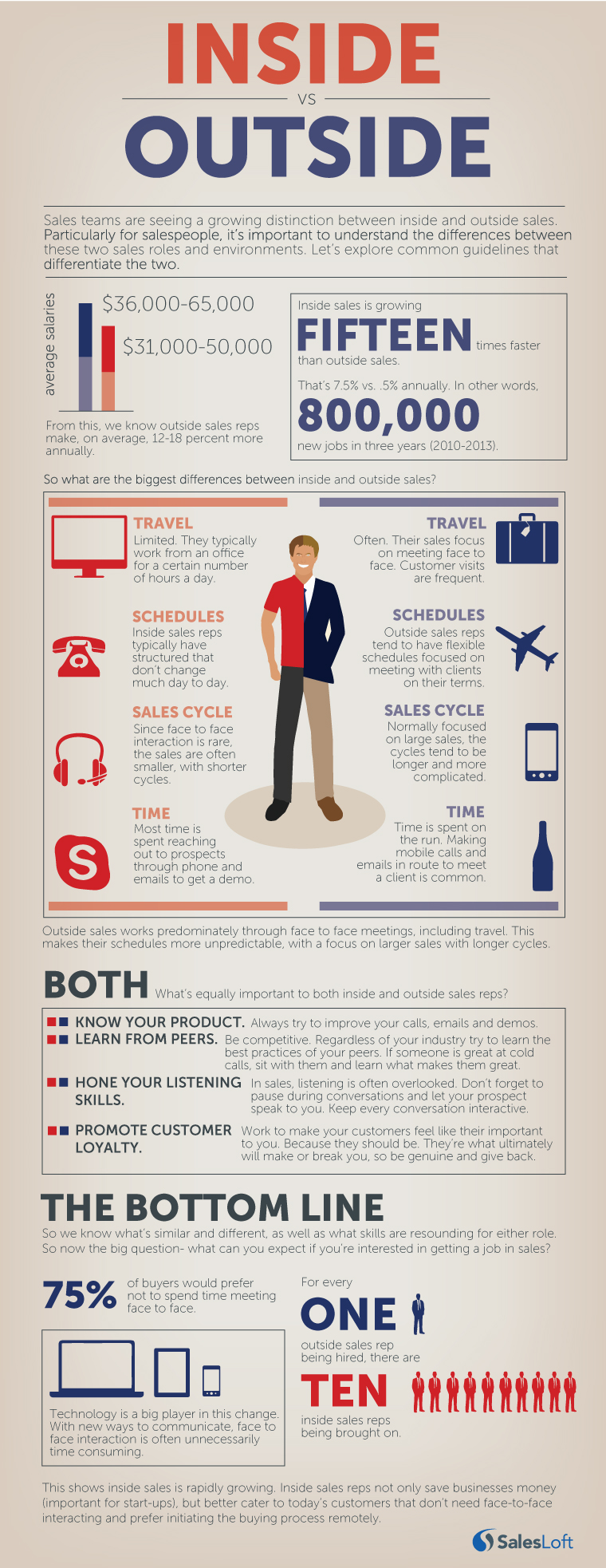Companies typically run their field sales operations on either an inside sales model or an outside sales model. Both operations are crucial to territory management, which is the process of assigning members of your field team into regions divided by product, experience, and other factors.
Inside Sales vs Outside Sales
Inside sales implies that salespeople report daily to the office and make sales inquiries to their leads over the phone, via web based virtual demos, or through another remote strategy. Outside sales include field reps who travel for more personal face to face meetings with clients in their territories and other services that benefit from a physically present representative. Quality vs. quantity is a simple way to sum up the different types of deals that come out of outside and inside selling respectively.
Today, companies that use inside sales are generally more prolific, and are growing more rapidly than outside sales organizations. However, this doesn't rule out the benefits of outside sales. The two are inherently different in the kind of sales they bring in. This is something to consider before deciding which model to follow. Should your company choose one, or incorporate smaller teams of both styles to attack sales territories? It all depends on your business and your product.
The Case for Inside Sales
Inside reps do most of their selling from their desks over the phone. Not having to travel at all allows them to pitch the product at a mass volume to many people everyday.
Inside sales also allows for much easier prospecting. Ken Krogue notes that prospecting has become almost entirely an inside sales process, with most field sales reps choosing to first reach prospective clients and postings over the phone rather than face to face. Inside sales tends to fall on the quantity side of the spectrum, which is not to say the customers are of a lower quality, but they are less likely to be big ticket purchases.
In general, items purchased over the phone are ordered in smaller quantities with a shorter sales cycle. Wallace Management Group notes that companies with inside sales teams tend to be centered around a lower cost product, lower complexity, and small scale orders. This makes sense, as companies who are willing to spend a lot of money on a complex, industry altering product usually want to meet face to face with a rep to work out price and functionality. However, inside sales makes up for lower cost with a larger volume.
The Case for Outside Sales
While inside sales reps make seven times as many pitches, outside sales reps convert prospects to clients 40% of the time. Inside reps close new business only 18% of the time, says Krogue. With their face to face meetings, outside sales reps are able to cultivate strong relationships with clients and continue selling to them over a longer period of time making for a longer, more complex sales cycle, according to SalesLoft. Field sales lends itself to businesses and products that demand a lot of service, attention, or set up.
For example, field sales reps who sell their products in retail locations need to be able to visit the store to set up product displays and keep their product in stock. Another advantage of field reps is that they are able to utilize more methods for sales such as presentations, displays, and samples. This keeps prospects engaged and more likely to buy, as visuals are processed 60,000 times faster than written text. Because of the time, travel, and long-term relationships of field sales reps, they subscribe more to the quality over quantity mantra.

Recently, many companies have been switching to inside sales models. Today, for every one field rep hired, ten inside reps are hired. However, this does not mean field reps are obsolete in the current sales market. A Harvard Business Review study on changing sales dynamics shows that while many organizations are switching to inside sales, they still need and appreciate the relationships built by field reps.
3 Territory management tips for outside sales
Because Outside sales reps are out in the field making with clients, they are generally assigned to districts known as sales territories. These territories can be assigned based upon a sales rep’s experience with a product, relationship with clients, and more. Here are 3 tips to keep in mind when creating your outside sales strategy.
- Maximize your scheduling - As your team begins to meet with clients, you’ll quickly learn which visits are like quick pit stops and which ones take a little longer than expected. Becoming familiar with timing will help you plan the most efficient routes from customer to customer.
- Track Data to stay ahead of the competition - Collect and analyze data to learn about which strategies are effective and which ones need to be altered.
- Prioritize your most valuable territories - Your best sales reps should be assigned to the territories with the greatest potential.
So is Inside Sales or Outside Sales Best for Your Company?
If you are selling to both small and large companies, the answer may be a hybrid sales solution that uses both kinds of sales. Outside field reps can handle large accounts that require a constant hands on presence, while inside reps are able to sell more to smaller businesses remotely, who will not need as much interaction.
When deciding which sales model to choose, first analyze what it is your business is selling, and to whom you are selling. Despite inside sales recent drive in popularity, if your business is selling a pricey product to a large organization, outfitting your business with an entirely inside sales team may not get you far.
The converse could result in a small business’ annoyance at having to take time out of their schedule for a face to face meeting. Having both systems in place can be mutually beneficial depending on what you are selling. Know your product, the differences for inside vs outside sales, manage & learn your customers, and go from there!





